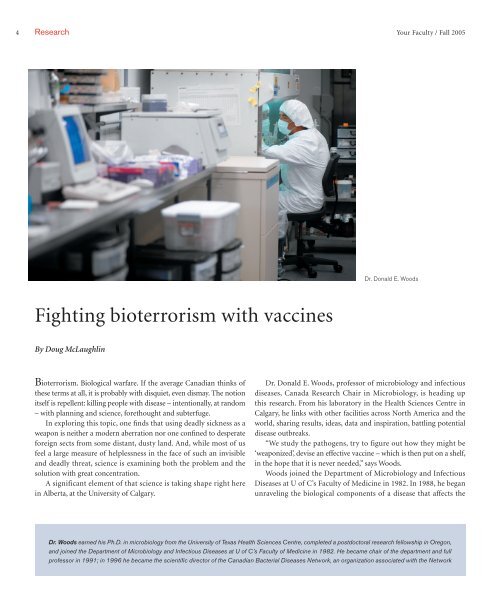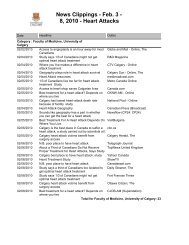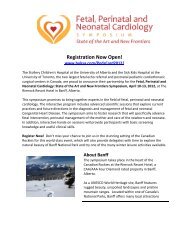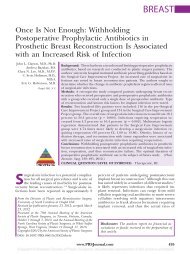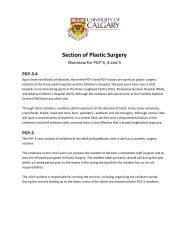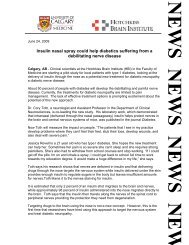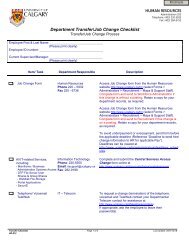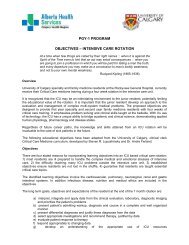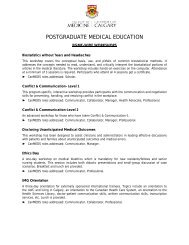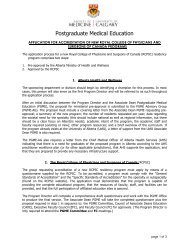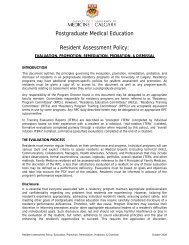Your Faculty / Fall 2005 - Faculty of Medicine - University of Calgary
Your Faculty / Fall 2005 - Faculty of Medicine - University of Calgary
Your Faculty / Fall 2005 - Faculty of Medicine - University of Calgary
You also want an ePaper? Increase the reach of your titles
YUMPU automatically turns print PDFs into web optimized ePapers that Google loves.
4<br />
Research <strong>Your</strong> <strong>Faculty</strong> / <strong>Fall</strong> <strong>2005</strong><br />
Dr. Donald E. Woods<br />
Fighting bioterrorism with vaccines<br />
By Doug McLaughlin<br />
B<br />
ioterrorism. Biological warfare. If the average Canadian thinks <strong>of</strong><br />
these terms at all, it is probably with disquiet, even dismay. The notion<br />
itself is repellent: killing people with disease – intentionally, at random<br />
– with planning and science, forethought and subterfuge.<br />
In exploring this topic, one finds that using deadly sickness as a<br />
weapon is neither a modern aberration nor one confined to desperate<br />
foreign sects from some distant, dusty land. And, while most <strong>of</strong> us<br />
feel a large measure <strong>of</strong> helplessness in the face <strong>of</strong> such an invisible<br />
and deadly threat, science is examining both the problem and the<br />
solution with great concentration.<br />
A significant element <strong>of</strong> that science is taking shape right here<br />
in Alberta, at the <strong>University</strong> <strong>of</strong> <strong>Calgary</strong>.<br />
Dr. Donald E. Woods, pr<strong>of</strong>essor <strong>of</strong> microbiology and infectious<br />
diseases, Canada Research Chair in Microbiology, is heading up<br />
this research. From his laboratory in the Health Sciences Centre in<br />
<strong>Calgary</strong>, he links with other facilities across North America and the<br />
world, sharing results, ideas, data and inspiration, battling potential<br />
disease outbreaks.<br />
“We study the pathogens, try to figure out how they might be<br />
‘weaponized’, devise an effective vaccine – which is then put on a shelf,<br />
in the hope that it is never needed,” says Woods.<br />
Woods joined the Department <strong>of</strong> Microbiology and Infectious<br />
Diseases at U <strong>of</strong> C’s <strong>Faculty</strong> <strong>of</strong> <strong>Medicine</strong> in 1982. In 1988, he began<br />
unraveling the biological components <strong>of</strong> a disease that affects the<br />
Dr. Woods earned his Ph.D. in microbiology from the <strong>University</strong> <strong>of</strong> Texas Health Sciences Centre, completed a postdoctoral research fellowship in Oregon,<br />
and joined the Department <strong>of</strong> Microbiology and Infectious Diseases at U <strong>of</strong> C’s <strong>Faculty</strong> <strong>of</strong> <strong>Medicine</strong> in 1982. He became chair <strong>of</strong> the department and full<br />
pr<strong>of</strong>essor in 1991; in 1996 he became the scientific director <strong>of</strong> the Canadian Bacterial Diseases Network, an organization associated with the Network


